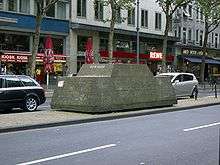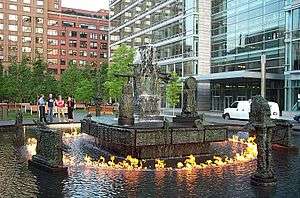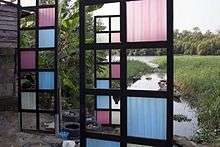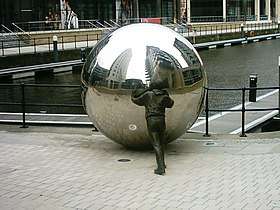Public art
The term public art refers to a specific art genre[1] with its own professional and critical discourse. It represents art in any media whose form, function and meaning are created for the general public through a public process. Public art is visually and physically accessible to the public – it is installed or staged in public space or the public realm, usually outside. Public art embodies public or universal concepts rather than commercial, partisan or personal concepts or interests, and it has clear aesthetic qualities in form or theme.[2] Notably, public art is also the direct or indirect product of a public process of creation, procurement, and/or maintenance.[2][3][4][5]

Independent art created or staged in or near the public realm (for example, graffiti, street art, yard art/lawn ornaments) lacks official or tangible public sanction and is not within the public art genre.[6] Such unofficial artwork may exist on private property immediately adjacent to the public realm, on public property or in natural settings but, however ubiquitous,[7][8] it falls outside the definition of public art by its absence of public process or public sanction as bona fide public art.[6]
Characteristics of public art
Common characteristics of public art are public accessibility, public realm placement, public process (including public funding), originality, and longevity.[2][3] According to K. M. Williamson, director of Public Art in Public Places, the following four public art characteristics are fundamental and help to distinguish public art from both "non-public" art and "non-art" in public.[2]
Public accessibility: placement in public space/public realm
Public art is publicly accessible, both physically and/or visually.[2] When public art is installed on privately-owned property, general public access rights still exist.[9]
Public art is characterized by site specificity, where the artwork is "created in response to the place and community in which it resides"[5] and by the relationship between its content and the public.[10] Cher Krause Knight states that "art's publicness rests in the quality and impact of its exchange with audiences ... at its most public, art extends opportunities for community engagement but cannot demand particular conclusion,” it introduces social ideas but leaves room for the public to come to their own conclusions.[10]
Public process, public funding
Public art is characterized by community involvement and collaboration.[3][10] Public art projects involve "an interactive process involving artists, architects, design professionals, community residents, civic leaders, politicians, approval agencies, funding agencies, and construction teams."[4]
Public art is often created and provided within formal "art in public places" programs that can include community arts education and art performance. Such programs may be financed by government entities through Percent for Art initiatives.[2]
Original, one-of-a-kind
Public art is usually unique, original and one-of-a-kind. Reproductions of prints or photographs are generally not considered public art.[3]
Longevity
Public art is planned and designed for stability and permanence.[3] Its placement in, or exposure to, the physical public realm requires both safe and durable materials. Public artworks are designed to withstand the elements (sun, wind, water) as well as human activity. Unlike gallery, studio or museum artworks which can be transferred or sold, public art is legally protected by the Visual Artists Rights Act of 1990 (VARA) which requires an official deaccession process for sale or removal.
Forms of public art
The following forms of public art identify to what extent public art may be physically integrated with the immediate context or environment. These forms, which can overlap, employ different types of public art that suit a particular form of environment integration.[2][11]
- stand alone: for example, sculptures, statues, structures
- integrated (into façades, pavements, or landscapes): for example, bas reliefs, Hill figure, Geoglyph, Petroglyph, mosaics, digital lighting
- applied (to a surface): for example, murals, building-mounted sculptures[2]
- installation (where artwork and site are mutually embedded): for example, transit station art[2]
- ephemeral (or non-permanent): performances, temporary installations: for example, a precarious rock balance or an instance of colored smoke.[2][12][13][14]
History of public art

United States, 20th century
In the 1930s, the production of national symbolism implied by 19th century monuments starts being regulated by long-term national programs with propaganda goals (Federal Art Project, United States; Cultural Office, Soviet Union). Programs like President Roosevelt's New Deal facilitated the development of public art during the Great Depression but was wrought with propaganda goals. New Deal art programs were intended to develop national pride in American culture while avoiding addressing the faltering economy.[10] Although problematic, New Deal art programs such as FAP altered the relationship between the artist and society by making art accessible to all people.[10] The New Deal program Art-in-Architecture (A-i-A) developed percent for art programs, a structure for funding public art still utilized today. This program allotted one half of one percent of total construction costs of all government buildings to the purchase of contemporary American art for them.[10] A-i-A helped solidify the policy that public art in the United States should be truly owned by the public. It also promoted site-specific public art.[10]
The approach to public art radically changed during the 1970s, following the civil rights movement’s claims on public space, the alliance between urban regeneration programs and artistic efforts at the end of the 1960s, and revised ideas of sculpture.[15] Public art acquired a status beyond mere decoration and visualization of official national histories in public space. Public art became much more about the public.[10] This perspective was reinforced in the 1970s by urban cultural policies, for example the New York-based Public Art Fund and urban or regional Percent for Art programs in the United States and Europe. Moreover, public art discourse shifted from a national to a local level, consistent with the site-specific trend and criticism of institutional exhibition spaces emerging in contemporary art practices.
Environmental public art

Between the 1970s and the 1980s, gentrification and ecological issues surfaced in public art practice both as a commission motive and as a critical focus by artists. The individual, Romantic retreat element implied in the conceptual structure of Land art, and its will to reconnect the urban environment with nature, is turned into a political claim in projects such as Wheatfield – A Confrontation (1982) by American artist Agnes Denes, as well as in Joseph Beuys’ 7000 Oaks (1982). Both projects focus on the increase of ecological awareness through a green urban design process, bringing Denes to plant a two-acre field of wheat in downtown Manhattan and Beuys to plant 7000 oaks coupled with basalt blocks in Kassel, Germany in a guerrilla or community garden fashion. In recent years, programs of green urban regeneration aiming at converting abandoned lots into green areas regularly include public art programs. This is the case for High Line Art, 2009, a commission program for the High Line, derived from the conversion of a portion of railroad in New York City; and of Gleisdreieck, 2012, an urban park derived from the partial conversion of a railway station in Berlin which hosts, since 2012, an open-air contemporary art exhibition.
The 1980s also witnessed the institutionalization of sculpture parks as curated programs. While the first public and private open-air sculpture exhibitions and collections dating back to the 1930s[16] aimed at creating an appropriate setting for large-scale sculptural forms difficult to show in museum galleries, installations such as Noguchi’s garden in Queens, New York (1985) reflect the necessity of a permanent relationship between the artwork and its site.
This relationship also develops in Donald Judd’s project for the Chinati Foundation (1986) in Texas, which advocates for the permanent nature of large-scale installations whose fragility may be destroyed when re-locating the work.
Sustainability and public art

Public art faces a design challenge by its very nature: how best to activate the images in its surroundings. The concept of “sustainability” arises in response to the perceived environmental deficiencies of a city. Sustainable development, promoted by the United Nations since the 1980s, includes economical, social, and ecological aspects. A sustainable public art work would include plans for urban regeneration and disassembly. Sustainability has been widely adopted in many environmental planning and engineering projects. Sustainable art is a challenge to respond the needs of an opening space in public.
In another public artwork titled "Mission leopard"[17] was commissioned in 2016 in Haryana, India, among the remote deciduous terrain of Tikli village a team coordinated by Artist Hunny Mor painted two leopards perched on branches on a water source tank 115 feet high. The campaign was aimed to spread awareness on co-habitation and environmental conservation. The art work can be seen from several miles across in all directions.
Interactive public art

Some public art is designed to encourage direct hands-on interaction. Examples include public art that contain interactive musical, light, video, or water components. For example, the architectural centerpiece in front of the Ontario Science Centre is a fountain and musical instrument (hydraulophone) where people can produce sounds by blocking water jets to force water through sound-producing mechanisms. An early and unusual interactive public artwork was Jim Pallas' 1980 Century of Light in Detroit, Michigan[18] of a large outdoor mandala of lights that reacted in complex ways to sounds and movements detected by radar (mistakenly destroyed 25 years later[19]).
New genre public art
In the 1990s, some artists called for artistic social intervention in public space. These efforts employed the term "new genre public art" in addition to the terms "contextual art", "relational art", "participatory art", "dialog art", "community-based art", and "activist art." “New genre public art” is defined by Suzanne Lacy as “socially engaged, interactive art for diverse audiences with connections to identity politics and social activism.”[10] Rather than metaphorically reflecting social issues, new genre public art strove to explicitly empower marginalized groups while maintaining aesthetic appeal.[10] An example was curator Mary Jane Jacob's 1993 performance art show ‘’Culture in Action’’ that investigated social systems though engagement with audiences that typically did not visit traditional art museums.[10]
Curated public art

The term "curated public art" refers to public art produced by a community or public who "commissions" a work in collaboration with a curator-mediator. An example is the doual'art project in Douala (Cameroon, 1991) that is based on a commissioning system that brings together the community, the artist and the commissioning institution for the realization of the project.
Controversies
Public art is sometimes controversial. The following public art controversies have been notable:
- Detroit's Heidelberg Project was controversial for several decades since its inception in 1986 due to its garish appearance.
- Richard Serra's minimalist piece Tilted Arc was removed from Foley Square in New York City in 1989 after office workers complained their work routine was disrupted by the piece. A public court hearing ruled against continued display of the work.
- Victor Pasmore's Apollo Pavilion in the English New Town of Peterlee has been a focus for local politicians and other groups complaining about the governance of the town and allocation of resources. Artists and cultural leaders mounted a campaign to rehabilitate the reputation of the work with the Baltic Centre for Contemporary Art commissioning artists Jane and Louise Wilson to make a video installation about the piece in 2003.
- Pierre Vivant's Traffic Light tree near Canary Wharf, also in East London, caused some confusion from motorists when constructed in 1998, some of whom believed them to be real traffic signals. However, once the piece became more famous, it was voted the favourite roundabout in the country by a survey of Britain's motorists.
- Maurice Agis' Dreamspace V, a huge inflatable maze erected in Chester-le-Street, County Durham, killed two women and seriously injured a three-year-old girl in 2006 when a strong wind broke its moorings and carried it 30 ft into the air, with thirty people trapped inside.[20]
- 16 Tons, Seth Wulsin's vast 2006 work includes the demolition of the raw material it works with, a former jail in Buenos Aires. In order to gain authorization to carry out the project, Wulsin had to engage a network of local, city and national government agencies, as well as former prisoners of the jail, human rights groups, and the military.[21]
Online documentation
Online databases of local and regional public art emerged in the 1990s and 2000s in tandem with the development of web-based data. Online public art databases can be general or selective (limited to sculptures or murals), and they can be governmental, quasi-governmental, or independent. Some online databases, such as the Smithsonian American Art Museum's Archives of American Art, include public artworks in their databases but do not classify them as such.
Public Art in Public Places Project was one of the first non-government organizations to create one of the most extensive online public art databases with digitally mapped listings throughout the Los Angeles, Southern California and Hawaii regions. In partnership with Google Search/Maps and the Google Cultural Institute it produces exhibits on permanent public artworks, including monuments, memorials, landmarks, and tourist attractions that contain public art features or components.
The WikiProject Public art project began in 2009 and strove to document public art around the globe. While this project received initial attention from the academic community, it mainly relied on temporary student contributions.[22] Its status is currently unknown.
See also
References
- "Google Arts & Culture | Public Art". Google Arts & Culture. Oxford University Press. Retrieved February 24, 2020.
- Williamson, K. M. (January 2020). "What is Public Art". Public Art in Public Places. Public Art in Public Places Project. Retrieved May 14, 2020.
- "Public Art: An Introduction". Project for Public Spaces. January 1, 2010. Retrieved March 5, 2020.
- "What is Public Art?". Association for Public Art. 2020. Retrieved March 5, 2020.
- "Americans for the Arts | Public Art". Americans for the Arts. Retrieved March 6, 2020.
- Williamson, K. M. (January 2020). "What is Not Public Art". Public Art in Public Places. Public Art in Public Places Project. Retrieved March 5, 2020.
- Rafael Schacter, "The World Atlas of Street Art and Graffiti", September, 2013; ISBN 9780300199420.
- "Rafael Schacter and His "World Atlas of Street Art and Graffiti"". www.brooklynstreetart.com. 2014-02-13. Retrieved 2018-10-26.
- Kayden, Jerold S. (2000). Privately Owned Public Space. New York: John Wiley & Sons, Inc. p. 23. ISBN 0-471-36257-3.
- Knight, Cher Krause (2008). Public Art: theory, practice and populism. Oxford: Blackwell Publishing. ISBN 978-1-4051-5559-5.
- "Forms of Public Art | Western Australia Department of Arts and Culture". Government of Western Australia. Retrieved March 6, 2020.
- "Interview with Rafael Schacter, Author of the Amazing New Book: The World Atlas of Street Art and Graffiti ~ L.A. TACO". L.A. TACO. 2013-11-13. Retrieved 2018-10-26.
- Brooks, Raillan (2013-12-06). "Aerosol Art". The New York Times. Retrieved 2018-10-26.
- "Silence / Shapes – Filippo Minelli Studio". www.filippominelli.com. Retrieved 2018-10-26.
- Rosalind Krauss, “Sculpture in the Expanded Field”, in: October, vol. 8, spring 1979, pp. 30-44
- Plastik, in Zurich, Switzerland, 1931, and Brookgreen Gardens, 1932, South Carolina
- Nov 26, Pratyush Patra | TNN |; 2016; Ist, 1:00. "Gurgaon needs public art on wildlife conservation, say artists who painted leopards on water tank | Gurgaon News - Times of India". The Times of India. Retrieved 2019-12-30.CS1 maint: numeric names: authors list (link)
- "Pallas/Century of Light". jpallas.com. Retrieved 2018-10-26.
- Pallas, Jim (2017). "Century of Light Shines for Twenty-Five Years". Leonardo. 50 (3): 246–252. doi:10.1162/LEON_a_01151.
- Stokes, Paul (24 July 2006). "Women killed as artwork floats off". The Daily Telegraph. London.
- "Página/12 :: espectaculos". Pagina12.com.ar. Retrieved 2014-07-26.
- Mary Helen, Miller (4 April 2010). "Scholars Use Wikipedia to Save Public Art From the Dustbin of History". The Chronicle of Higher Education. Retrieved 16 October 2010.
Bibliography
- Cartiere, Cameron, and Martin Zebracki, eds. The Everyday Practice of Public Art: Art, Space, and Social Inclusion. Routledge, 2016.
- Williamson, K. M. "Public Art in the Hands of the Public Realm," in Developing Civic Engagement in Urban Public Art Programs, edited by Jessica L. DeShazo and Zachary Smith. Rowman & Littlefield, 2015.
- Zebracki, Martin. Public Artopia: Art in Public Space in Question. Amsterdam University Press, 2012.
- Chris van Uffelen: 500 x Art in Public: Masterpieces from the Ancient World to the Present. Braun Publishing, 1. Auflage, 2011, 309 S., in Engl. [Mit Bild, Kurzbiografie und kurzer Beschreibung werden 500 Künstler mit je einem Kunstwerk im öffentlichen Raum vorgestellt. Alle Kontinente (außer der Antarktis) und alle Kunststile sind vertreten.]
- Savage, Kirk. Monument Wars: Washington, DC, the National Mall, and the Transformation of the Memorial Landscape. University of California Press, 2009.
- Powers, John. Temporary Art and Public Place: Comparing Berlin with Los Angeles. European University Studies, Peter Lang Publishers, 2009.
- Durante, Dianne. Outdoor Monuments of Manhattan: A Historical Guide. New York University Press, 2007.
- Ronald Kunze: Stadt, Umbau, Kunst: Sofas und Badewannen aus Beton in: STADTundRAUM, H., S. 62-65, 2/2006.
- Goldstein, Barbara, ed. Public Art by the Book, 2005.
- Federica Martini, Public Art in Mobile A2K Methodology guide, 2002.
- Florian Matzner (ed.): Public Art. Kunst im öffentlichen Raum, Ostfildern 2001
- Finkelpearl, Tom, ed. Dialogues in Public Art. MIT Press, 2000.
- Lacy, Susanne, ed. Mapping the Terrain: New Genre Public Art. Bay Press, 1995.
- Deutsche, Rosalyn. Evictions: Art and Spatial Politics. MIT Press, 1998.
- Burgin, Victor. In/Different Spaces: Place and Memory in Visual Culture. University of California Press, 1996.
- Miles, Malcolm. Art, Space and the City: Public Art and Urban Futures, 1997.
- Academy Group Ltd. Public Art, Art & Design. London, 1996
- Doss, Erika Lee. Spirit Poles and Flying Pigs: Public Art and Cultural Democracy in American Communities. Smithsonian Books, 1995.
- Senie, Harriet, and Sally Webster, eds. Critical Issues in Public Art: Content, Context, and Controversy. Harper Collins, 1992.
- Crimp, Douglas. On the Museum's Ruins. MIT Press, 1993.
- Miles, Malcolm, et al. Art For Public Places: Critical Essays, 1989.
- Volker Plagemann (ed.). Kunst im öffentlichen Raum. Anstöße der 80er Jahre, Köln, 1989
- Love, Suzanne, and Kim Dammers. The Lansing Area Arts Attitude Survey. Michigan State University Center for Urban Affairs, Lansing, 1978
- Herlyn, Sunke, Manske, Hans-Joachim, and Weisser, Michael (eds.). Kunst im Stadtbild - Von Kunst am Bau zu Kunst im öffentlichen Raum, (catalog for exhibition of the same name, at University of Bremen), Bremen, 1976
- Collection of scholarly publications on public art in Africa
External links
| Wikimedia Commons has media related to Public art. |
| Library resources about Public art |
- Public Art in Public Places Project
- Infecting the City Public Arts Festival
- Public Art Archive™
- CultureNOW's MuseumWithoutWalls Public Art Database
- Public art at Curlie
- Public sculpture in Perth Australia
- Public sculpture in Cape Town South Africa
- Public art in Africa, web dossier compiled by the library of the African Studies Centre, July 2019
